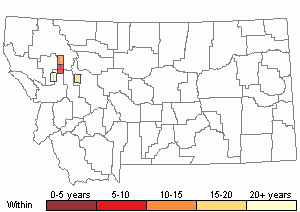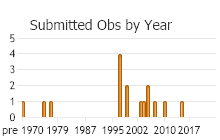View in other NatureServe Network Field Guides
NatureServe
Montana
Utah
Wyoming
Idaho
Wisconsin
British Columbia
South Carolina
Yukon
California
New York
Carinate Mountainsnail - Oreohelix elrodi
Other Names:
Pyramidula elrodi
General Description
The shell is large, to 28 mm diameter, height to 13 mm, but usually about 22 mm in diameter and 10 mm in height, heliciform with up to 5 to 5 1/2 whorls (new-born young about 3.5 mm in diameter, with 2 to 2 1/2 whorls), strongly depressed with a low spire, acutely carinate, with an open umbilicus to 6 mm diameter. Shell opaque and chalky, color is pale grayish to nearly white, sometimes with a very pale pinkish undertone; smaller shells may have a brownish cuticle that is lost in mature individuals. Inner (embryonic) whorls smooth then unevenly striate, later whorls lack spiral bands and are coarsely and irregularly ribbed on upper and lower surfaces, the last whorl descending somewhat to the aperture; the aperture is angular at the keeled periphery. Description for an alpine population on the Scapegoat Plateau is much as above except the shells are much smaller, to 15 mm diameter, 6.5 mm in height, and 4 1/2 whorls, but usually 10.5 mm diameter, 5 mm in height, and 4 whorls or less (Hendricks 1998, 2012; Hendricks et al. 2008; Burke 2013). Internal anatomy described by Pilsbry (1939) and Fairbanks (1984).
Phenology
Active in wet and cool weather; otherwise not described.
Diagnostic Characteristics
A combination of shell shape (flattened heliciform or flattened conic), large size (except alpine form, which is medium size), opaque shell color (especially chalky white when dead) with a few bands, absence of reflected lip, and absence of teeth in the aperture distinguishes this from other Montana land snails (Hendricks 2003, 2012; Burke 2013). Oreohelix elrodi is very unique in appearance from other Montana Oreohelix. It is medium to large and stongly depressed (flattened), acutely carinate (keeled), and the later whorls are coarsely sculptured with a series of ribs especially evident on the underside.
Species Range
Montana Range
Range Descriptions

 Native
Native
Range Comments
Montana endemic: 29 records from five sites in two counties west of, or near, the Continental Divide: Lake (28), Lewis and Clark (1). Elevation range 1097 to 2438 m (3600 to 8000 ft). Original description based on specimens collected in 1899 from slopes above McDonald Lake in the Mission Mountains, Lake County. Animals from the Scapegoat Plateau, Lewis and Clark County may be an unsubscribed subspecies or entirely different species. Populations in the Mission Mountains are probably isolated from those in the Scapegoat Plateau and Swan Range. Sometimes locally abundant; as many as 100 live animals and 400 shells were seen at the Lewis and Clark County site in late July (Hendricks et al. 2008; Hendricks 2012; Burke 2013).
Observations in Montana Natural Heritage Program Database
Number of Observations: 33
(Click on the following maps and charts to see full sized version)
Map Help and Descriptions
Relative Density

Recency



 (Observations spanning multiple months or years are excluded from time charts)
(Observations spanning multiple months or years are excluded from time charts)
Migration
Non-migratory. May may vertical movements through talus and boulder fields (Hendricks 1998).
Habitat
Described originally as exposed limestone talus below tree line, but examination of the rock at four of five sites revealed they are predominantly argillite, sometimes with diorite or minor amounts of limestone. Occupied sub-alpine talus sites may lack forest canopy altogether or occur under an open mixed conifer canopy including Douglas-fir, western larch, ponderosa pine, western redcedar (near streams), with aspen, paper birch and mock orange scattered along the margins of talus slopes. The exception is an expanse of limestone well above tree line on the Scapegoat Plateau. Live animals present mostly within the talus under or on rocks, or in accumulations of duff within the talus (Hendricks 1998, 2012; Hendricks et al. 2008).
Food Habits
Not described. May feed on leaf detritis and duff (Hendricks 1998).
Reproductive Characteristics
Hermaphroditic (Pilsbry 1939; Fairbanks 1984), otherwise not described.
Stewardship Responsibility
Threats or Limiting Factors
Habitat occupied by Oreohelix elrodi (low-elevation slopes of mixed conifers, especially Douglas-fir, Ponderosa Pine and Western Larch) is threatened to some extent by logging, grazing, and fire, although occupied habitat is often in talus surrounded by mixed coniferous forest. Habitat requirements and food habits are poorly understood, however. Fire suppression efforts (especially use of fire retardants) and talus destabilization (trail maintenance, modification) could have negative impacts, as could chemical control of weeds (Frest and Johannes 1995; Hendricks 2003). The alpine site on the Scapegoat Plateau is most threatened by changes in climate.
References
- Literature Cited AboveLegend:
 View Online Publication
View Online Publication Burke, T. E. 2013. Land snails and slugs of the Pacific Northwest. Corvallis, OR: Oregon State University Press. 344 p.
Burke, T. E. 2013. Land snails and slugs of the Pacific Northwest. Corvallis, OR: Oregon State University Press. 344 p. Fairbanks, H.L. 1984. A new species of Oreohelix (Gastropoda: Pulmonata: Oreohelicidae) from the Seven Devils Mountains, Idaho. Proceedings of the Biological Society of Washington 97(1):179-185.
Fairbanks, H.L. 1984. A new species of Oreohelix (Gastropoda: Pulmonata: Oreohelicidae) from the Seven Devils Mountains, Idaho. Proceedings of the Biological Society of Washington 97(1):179-185. Frest, T.J. and E.J. Johannes. 1995. Interior Columbia Basin mollusk species of special concern. Final report to the Interior Columbia Basin Ecosystem Management Project, Walla Walla, WA. Contract #43-0E00-4-9112. 274 pp. plus appendices.
Frest, T.J. and E.J. Johannes. 1995. Interior Columbia Basin mollusk species of special concern. Final report to the Interior Columbia Basin Ecosystem Management Project, Walla Walla, WA. Contract #43-0E00-4-9112. 274 pp. plus appendices. Hendricks, P. 1998. Rediscovery of Discus brunsoni Berry, 1955 and Oreohelix alpina (Elrod 1901) in the Mission Mountains, Montana, with comments on Oreohelix elrodi (Pilsbry 1900). The Nautilus 112(2): 58-62.
Hendricks, P. 1998. Rediscovery of Discus brunsoni Berry, 1955 and Oreohelix alpina (Elrod 1901) in the Mission Mountains, Montana, with comments on Oreohelix elrodi (Pilsbry 1900). The Nautilus 112(2): 58-62. Hendricks, P. 2003. Status and conservation management of terrestrial mollusks of special concern in Montana. Unpublished report prepared for the U.S. Forest Service. Montana Natural Heritage Program, Helena, Montana. 67 pp. + appendices.
Hendricks, P. 2003. Status and conservation management of terrestrial mollusks of special concern in Montana. Unpublished report prepared for the U.S. Forest Service. Montana Natural Heritage Program, Helena, Montana. 67 pp. + appendices. Hendricks, P. 2012. A Guide to the Land Snails and Slugs of Montana. A report to the U.S. Forest Service - Region 1. Montana Natural Heritage Program, Helena, MT. vii + 187 pp. plus appendices.
Hendricks, P. 2012. A Guide to the Land Snails and Slugs of Montana. A report to the U.S. Forest Service - Region 1. Montana Natural Heritage Program, Helena, MT. vii + 187 pp. plus appendices. Hendricks, P., B.A. Maxell, S. Lenard, and C. Currier. 2008. Surveys and predicted distribution models for land mollusks on USFS Northern Region Lands: 2007. Report to the USDA Forest Service, Northern Region. Helena, MT: Montana Natural Heritage Program. 12 pp. + appendices.
Hendricks, P., B.A. Maxell, S. Lenard, and C. Currier. 2008. Surveys and predicted distribution models for land mollusks on USFS Northern Region Lands: 2007. Report to the USDA Forest Service, Northern Region. Helena, MT: Montana Natural Heritage Program. 12 pp. + appendices. Pilsbry, H.A. 1939. Land Mollusca of North America (North of Mexico), Volume 1, Part 1. Monograph of the Academy of Natural Sciences of Philadelphia Monograph Number 3 (1): 1-573.
Pilsbry, H.A. 1939. Land Mollusca of North America (North of Mexico), Volume 1, Part 1. Monograph of the Academy of Natural Sciences of Philadelphia Monograph Number 3 (1): 1-573.
- Additional ReferencesLegend:
 View Online Publication
View Online Publication
Do you know of a citation we're missing? Elrod, M.J. 1901b. Montana shells. Rocky Mountain Magazine (May) 2(3):691-697.
Elrod, M.J. 1901b. Montana shells. Rocky Mountain Magazine (May) 2(3):691-697. Elrod, M.J. 1902. A biological reconnoissance in the vicinity of Flathead Lake. Bulletin of the University of Montana Number, Biological Series 10(3):89-182.
Elrod, M.J. 1902. A biological reconnoissance in the vicinity of Flathead Lake. Bulletin of the University of Montana Number, Biological Series 10(3):89-182. Elrod, M.J. 1903a. Notes on Pyramidula elrodi [Oreohelix elrodi] Pils. The Nautilus, 16:109-112.
Elrod, M.J. 1903a. Notes on Pyramidula elrodi [Oreohelix elrodi] Pils. The Nautilus, 16:109-112. Hendricks, P. 2005. Surveys for animal species of concern in northwestern Montana. Unpublished report to the Montana Department of Fish, Wildlife & Parks, Montana Natural Heritage Program, Helena, Montana, May 2005. 53 p.
Hendricks, P. 2005. Surveys for animal species of concern in northwestern Montana. Unpublished report to the Montana Department of Fish, Wildlife & Parks, Montana Natural Heritage Program, Helena, Montana, May 2005. 53 p. Linscott, T.M., K. Weaver, V. Morales, and C.E. Parent. 2020. Assessing species number and genetic diversity of the Mountainsnails (Oreohelicidae). Conservation Genetics 21:971-985.
Linscott, T.M., K. Weaver, V. Morales, and C.E. Parent. 2020. Assessing species number and genetic diversity of the Mountainsnails (Oreohelicidae). Conservation Genetics 21:971-985. Pilsbry, H.A. 1900. Notices of new American land snails. The Nautilus 14:40-41.
Pilsbry, H.A. 1900. Notices of new American land snails. The Nautilus 14:40-41. Stabins, H. 2004. Forest owl and invertebrate monitoring report for northwestern Montana Plum Creek managed landscapes for 2003 and 2004. Plum Creek.
Stabins, H. 2004. Forest owl and invertebrate monitoring report for northwestern Montana Plum Creek managed landscapes for 2003 and 2004. Plum Creek.
- Web Search Engines for Articles on "Carinate Mountainsnail"
- Additional Sources of Information Related to "Snails / Slugs"





